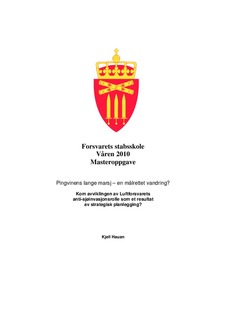| dc.description.abstract | This study seeks to broaden the understanding of the strategic planning processes in the Norwegian armed Forces. By applying the same theoretical and methodological tools used in the study regarding the implementation of an Air-to-Ground capacity in the Royal Norwegian Air Force (Nergård, 2009), the abandoning of the anti-sea invasion role in the same organization will be explored. The purpose is twofold. Firstly; the study seeks to validate the former study by using the same scientific design and theoretical platform when exploring a different phenomenon within the same organization. The findings from the respective studies are then being compared in order to identify similarities and differences. Secondly; the study seeks to give an enhanced understanding of the processes leading up to the abandoning of the F-16’s anti-sea-invasion role in 2004. As a tool to increase the understanding of these processes, two theories are being utilized. The first theory describes a situation where the organization’s strategies are created by the Executive Officer and formulated by his staff. The strategies are then converted into plans and in turn cascaded down into the organization for implementation. The other theory describes a situation where initiatives taken elsewhere in the organization, over time could become a part of the organization’s realized strategy. The study is based on military strategic plans and other relevant written documentation. In addition 11 persons working at different echelons in the Norwegian Armed forces have been interviewed. The study suggests perceiving strategy development as a continuous process in an environment where the existing strategy will be under constant pressure by entities with influence, even when the organization’s strategic plans are explicit. The study also suggests that changes in the organization’s strategy over time will come as a result of a series of strategic decisions not necessarily reflected in the strategic plans. | en_US |
